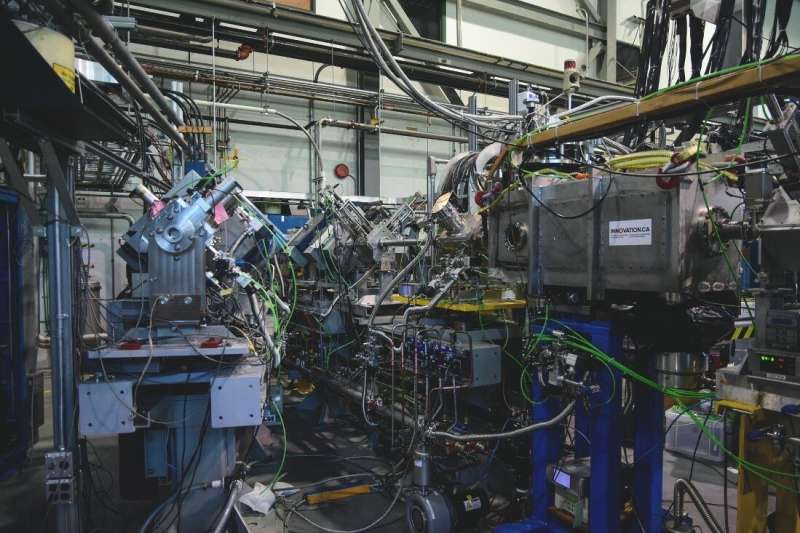A glimpse of deformation in helium-8

New TRIUMF research from the Saint Mary’s University-led IRIS group has unveiled an unexpected shape deformation in the nucleus of helium-8 (He8), providing further insight into the unique dynamics of how neutron-rich nuclei take shape and maintain stability.
Published on November 10, 2021 in Physics Letters B, Proton inelastic scattering reveals deformation in helium-8 combines high-precision and high-statistics experimental data gathered with the IRIS spectroscopy station and ab initio theoretical calculations undertaken by TRIUMF’s Theory Department to demonstrate a significant deformation in the arrangement of outer neutrons in He8.
In the nuclear shell model, protons and neutrons are arranged in the nucleus based on energy levels, or shells. Determining the precise rules of the shell model, especially for nuclei that are rich in neutrons, helps us better understand how elements are created in the Universe, and in what proportions.One key characteristic is shape. With a magic number of protons and a presumed neutron subshell, He8 has been predicted to be double closed-shell; since all double closed-shell nuclei have been shown to have spherical nuclei, one way to assess the neutron shell arrangement in He8 is to ask: is it spherical?
Led by IRIS post-doctoral research fellow Matthias Holl and Principal Investigator Rituparna Kanungo (also Professor of Physics at Saint Mary’s University, TRIUMF Affiliate Scientist, and IRIS lead), the experimental team used the IRIS spectroscopy station to study He8 via proton inelastic scattering, an experimental technique that involves smashing a stationary target (made of small nuclei, like the proton in hydrogen) with a fast-moving, energized stream of heavier nuclei.
The scatter pattern of the reaction products provides an energy fingerprint—a complex, highly distinctive indicator of the nuclear energy levels and arrangement of neutrons and protons. In this experiment, the team used a beam of +2 charged He8 at 8.25A MeV, produced using TRIUMF’s 520 MeV cyclotron and impinged on a novel solid hydrogen target cooled to 4 degrees Kelvin.
In their results, the team recorded a first excited energy state for He8 at 3.54(6) MeV—a large energy gap that supports the notion of a closed subshell at 6 neutrons. Its probability, however, signals it to have unexpectedly large deformation. The high-precision IRIS data were also found to be in agreement with first principles predictions that were pursued independently by Petr Navratil, TRIUMF Theory Department Head and acting Associate Laboratory Director, Physical Sciences Division. Theoretical predictions from collaborators from Oak Ridge National Laboratory, Lawrence Livermore National Laboratory, the University of Seville and the University of Tennessee reinforced the agreement with the data.
The theoretical predictions and the data consistency represent precise signatures of a shape deformation in He8, pointing to a rugby ball-shaped shell of neutrons surrounding a sphere of protons. The results indicate deeper nuclear interactions at play and open a new paradigm for future investigations.
“Here at TRIUMF, we can leverage the laboratory’s world-leading capacity to produce a variety of intense rare isotope beams, including He8,” said Kanungo. “But we also have the tremendous advantage of having access to a community of highly-qualified experimental and theoretical physicists, engineers, technicians, and others, and the unique infrastructure of IRIS, which allows us to investigate short-lived, exotic nuclei with high precision.”
“These results are an important building-block for our understanding of nuclear shell dynamics and the nature of matter,” said TRIUMF Deputy Director, Research Reiner Kruecken. “Further, the synergy between theory and experiment achieved here is a prime example of how TRIUMF brings together world-leading infrastructure, talent, and a network of academic and experimental collaborators to produce excellent science.”
Grabbing magic tin by the tail
M. Holl et al, Proton inelastic scattering reveals deformation in He8, Physics Letters B (2021). DOI: 10.1016/j.physletb.2021.136710
Provided by
TRIUMF
Citation:
A glimpse of deformation in helium-8 (2021, November 17)
retrieved 17 November 2021
from https://phys.org/news/2021-11-glimpse-deformation-helium-.html
This document is subject to copyright. Apart from any fair dealing for the purpose of private study or research, no
part may be reproduced without the written permission. The content is provided for information purposes only.
For all the latest Science News Click Here
For the latest news and updates, follow us on Google News.

